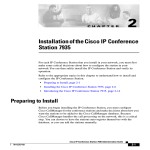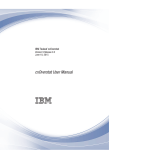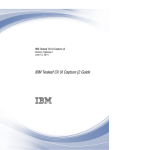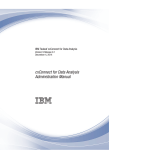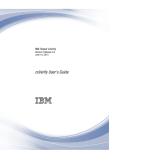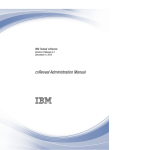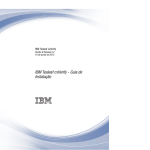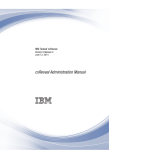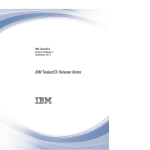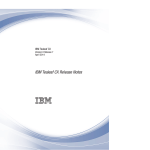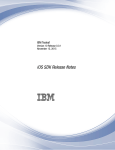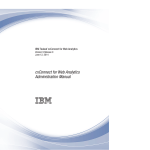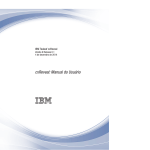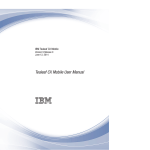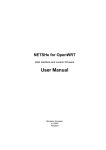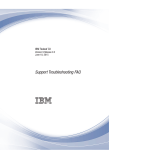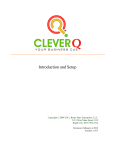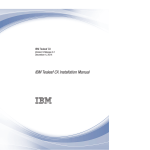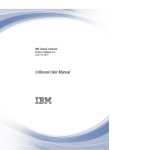Download IBM Tealeaf Customer Experience Overview Guide: IBM
Transcript
IBM Tealeaf Customer Experience
Version 9 Release 0.1
December 4, 2014
IBM Tealeaf Customer Experience
Overview Guide
Note
Before using this information and the product it supports, read the information in “Notices” on page 21.
This edition applies to version 9, release 0, modification 1 of IBM Tealeaf CX and to all subsequent releases and
modifications until otherwise indicated in new editions.
© Copyright IBM Corporation 1999, 2014.
US Government Users Restricted Rights – Use, duplication or disclosure restricted by GSA ADP Schedule Contract
with IBM Corp.
Contents
Chapter 1. Overview . . . . . . . . . 1
Benefits of IBM Tealeaf .
User interfaces. . . .
.
.
.
.
.
.
.
.
.
.
.
.
.
.
.
.
.
.
. 1
. 2
Chapter 2. IBM Tealeaf process flow . . 3
CX Passive Capture Application process flow .
Processing Server flow . . . . . . . . .
.
.
. 3
. 4
Chapter 3. IBM Tealeaf products . . . . 7
IBM Tealeaf CX . . . . . . . . .
Passive Capture Application overview .
CX RealiTea Viewer overview. . . .
CX UI Capture overview . . . . .
cxImpact. . . . . . . . . . . .
cxImpact Browser Based Replay . .
Session and visitor segments. . . .
cxView . . . . . . . . . . . .
Scorecards . . . . . . . . . .
Dashboards . . . . . . . . .
Report scheduling . . . . . . .
Report templates . . . . . . .
cxOverstat . . . . . . . . . . .
© Copyright IBM Corp. 1999, 2014
.
.
.
.
.
.
.
.
.
.
.
.
.
.
.
.
.
.
.
.
.
.
.
.
.
.
.
.
.
.
.
.
.
.
.
.
.
.
.
. 7
. 8
. 8
. 9
. 9
. 10
. 11
. 11
. 12
. 12
. 12
. 12
. 13
Form analytics . . . . . . . . . .
Link analytics . . . . . . . . . .
Comparison analytics . . . . . . . .
Heat maps. . . . . . . . . . . .
Attention maps . . . . . . . . . .
cxReveal . . . . . . . . . . . . .
Search with cxReveal . . . . . . . .
Replay with cxReveal . . . . . . . .
cxVerify . . . . . . . . . . . . .
cxConnect . . . . . . . . . . . . .
cxConnect for Data Analysis overview . .
cxConnect for Voice of Customer Overview.
cxConnect for Web Analytics Overview . .
cxConnect for Data Analysis overview . .
CX Mobile . . . . . . . . . . . . .
.
.
.
.
.
.
.
.
.
.
.
.
.
.
.
.
.
.
.
.
.
.
.
.
.
.
.
.
.
.
13
13
14
14
14
14
14
15
15
15
16
16
16
17
17
Chapter 4. IBM Tealeaf documentation
and help . . . . . . . . . . . . . . 19
Notices . . . . . . . . . . . . . . 21
Trademarks . . . . . . .
Privacy Policy Considerations .
.
.
.
.
.
.
.
.
.
.
.
.
. 23
. 23
iii
iv
IBM Tealeaf Customer Experience Overview Guide: IBM Tealeaf Customer Experience Overview Guide
Chapter 1. Overview
IBM® Tealeaf® offers a suite of customer experience management solutions that can
provide critical insights to help you meet your customer retention objectives. The
IBM Tealeaf Customer Experience Overview Guide provides an introduction to the
components and capabilities of Tealeaf.
Tealeaf captures all interactions between your visitors and your web applications
that they see. The captured interaction is reassembled in Tealeaf into a single entity,
and then made available for searching, replaying, reporting, and exporting. The
web experience of your visitor is not impeded when the interaction is forwarded to
Tealeaf.
You can use the Tealeaf user interfaces to interact with features and sessions.
Tealeaf provides three user interfaces: Tealeaf Portal, CX RealiTea Viewer (RTV)
and PCA Web Console. Each user interface provides different functions for the
users of Tealeaf.
Benefits of IBM Tealeaf
Use IBM Tealeaf to discover your customer's experience and understand their pain
points. With IBM Tealeaf, you can monitor your customers and your web or mobile
application, and analyse business impact.
You can make optimum use of IBM Tealeaf for the following activities:
v Monitoring how customers engage with your web and mobile applications
v Analyzing business impact
v Monitoring your web and mobile applications
The following table describes IBM Tealeaf benefits in detail.
Table 1. Benefits of IBM Tealeaf
Benefit
Description
Monitoring customers
IBM Tealeaf enables you to monitor how customers engage with your web and
mobile applications. You can monitor your customer interactions in the following
ways:
v Discovering locations where customers are struggling
v Instantly accessing customer sessions, including shadow browsing live web
application activity
v Building reports to monitor issues and key metrics
Analyzing business impact
You can effectively use IBM Tealeaf to measure the business impact of issues or
changes to your web and mobile applications.
Monitoring your web
application
You can use IBM Tealeaf to quickly locate technical problems with your web and
mobile applications, and monitor and retain an auditable record of online customer
activities for auditing and dispute resolution.
© Copyright IBM Corp. 1999, 2014
1
User interfaces
You can use the IBM Tealeaf user interfaces to interact with features and sessions.
IBM Tealeaf provides three user interfaces: Tealeaf Portal, CX RealiTea Viewer
(RTV), and PCA Web Console. Each user interface provides different functions for
the users of IBM Tealeaf.
The following table provides information about the IBM Tealeaf user interfaces:
Table 2. IBM Tealeaf user interfaces
Tealeaf user interface
Description
Tealeaf Portal
The Tealeaf Portal is a web application that
is the most common point of access for
Tealeaf users. You can use the Portal to
search for active and completed sessions,
replay the sessions, configure events and
reports, and monitor user and site activities.
See the IBM Tealeaf cxImpact User Manual for
more information.
CX RealiTea Viewer (RTV)
RTV is a Windows-based application that
can be installed on your desktop computer.
You can use RTV for searching and
replaying sessions.
See the IBM Tealeaf RealiTea Viewer User
Manual for more information.
PCA Web Console
IBM Tealeaf CX Passive Capture Application
(PCA) administrators can use the PCA Web
Console to monitor PCA performance and
apply configuration changes. Administrators
must use a separate URL and authentication
mechanism to access PCA Web console.
Note: If you are not a Linux administrator
responsible for managing the IBM Tealeaf
CX Passive Capture Application, you might
not require access to the PCA Web Console.
See the IBM Tealeaf Passive Capture
Application Manual for more information.
2
IBM Tealeaf Customer Experience Overview Guide: IBM Tealeaf Customer Experience Overview Guide
Chapter 2. IBM Tealeaf process flow
You can use IBM Tealeaf to monitor the interactions between your customers and
your web or mobile applications to analyze your business impact.
The following diagram explains the IBM Tealeaf process flow in brief:
Figure 1. IBM Tealeaf process flow
CX Passive Capture Application process flow
Capturing data is the first step in the IBM Tealeaf process flow. IBM Tealeaf CX
Passive Capture Application (CX PCA) captures data from your website or mobile
application.
© Copyright IBM Corp. 1999, 2014
3
The following diagram explains the CX PCA process flow:
Figure 2. CX PCA process flow
Processing Server flow
After the data is captured by CX PCA, it is sent to the processing server, which is
also known as Canister.
Data can be processed by one of the following servers:
v Single processing server
v Multiple processing servers
v Multiple processing servers and an HBR server to manage distribution to the
processing servers based on their current load
The following diagram explains the processing server flow in brief:
4
IBM Tealeaf Customer Experience Overview Guide: IBM Tealeaf Customer Experience Overview Guide
Figure 3. Processing server flow
The following types of Canisters exist:
Short Term Canister
The Short Term Canister is an in-memory database that is used for storing
active sessions.
Long Term Canister
The Long Term Canister is a database that is stored on the local disk of the
processing server to retain completed sessions and their related search
indexes for a configurable length of time.
The following points are applicable for the Short Term Canister:
Chapter 2. IBM Tealeaf process flow
5
v For each session, a timeout clock is reset with each new hit.
v Text in the hit is parsed for the occurrence of hit attributes and session attributes
that are used for event evaluation.
v The hit-level event conditions are processed, and events that fire are recorded
with the Session data in the STC.
v If the timeout clock expires for a session where no new hits are added, the
Session is written to the Long Term Canister, where completed sessions are
stored for a predefined number of days.
v In the Long Term Canister, the event counts are aggregated into 1-minute
buckets.
6
IBM Tealeaf Customer Experience Overview Guide: IBM Tealeaf Customer Experience Overview Guide
Chapter 3. IBM Tealeaf products
IBM Tealeaf offers a host of products that you can use to get quantitative data and
qualitative analysis that is necessary to understand your customer's online
experience.
The following products are powered by IBM Tealeaf:
v CX
– CX Passive Capture Application (PCA)
– CX RealiTea Viewer (RTV)
– CX UI Capture
v cxImpact
– Browser Based Replay (BBR)
v cxConnect
– cxConnect for Data Analysis
– cxConnect for Voice of Customer
– cxConnect for Web Analytics
– cxConnect for Digital Analytics Integration
v cxOverstat
– Form analytics
– Link analytics
– Comparison analytics
– Heat maps
– Attention maps
v cxReveal
– Search with cxReveal
– Replay with cxReveal
v cxVerify
v cxView
– Scorecards
– Dashboards
– Report scheduling
– Importing or exporting templates
v CX Mobile
– Android logging framework
– iOS logging framework
IBM Tealeaf CX
The IBM Tealeaf CX platform monitors communications between your web
application and visitors to it.
IBM Tealeaf CX is the base platform for all IBM Tealeaf products. You must install
IBM Tealeaf CX before installing any other IBM Tealeaf product.
© Copyright IBM Corp. 1999, 2014
7
The following image gives an idea about the IBM Tealeaf CX offering.
Passive Capture Application overview
IBM Tealeaf CX Passive Capture Application (PCA) captures and records the
complete interaction between the visitor and the web application environment by
using a network tap or network switch spanning port.
PCA has the following benefits:
v Introduces zero overhead, page latency, or CPU utilization to the web server
v Introduces zero risk of failure to the web application - monitored/captured
traffic is not part of the active traffic
v Supports any web application environment: homogenous or mixed, packaged, or
custom
v Supports encrypted (HTTPS) and non-encrypted (HTTP) traffic
v Reconstructs the HTTP traffic of the user experience for downstream processing
of user sessions and events
CX RealiTea Viewer overview
CX RealiTea Viewer (RTV) is a stand-alone application that is part of the IBM
Tealeaf cxImpact product suite. CX RTV provides the following significant
capabilities:
v Allows you to view a visual replay of a visitor's session with your web
application
v Allows you to examine the information that the visitor's browser sends to your
web server and the information that is returned by your web server in response
v Plays a key role in searching for sessions that meet specific criteria
v Presents specific, customizable information about each hit that matches a search
CX RealiTea Viewer includes software that is developed by the OpenSSL Project for
use in the http://www.openssl.org/. RTV provides the following perspectives on
session data:
8
IBM Tealeaf Customer Experience Overview Guide: IBM Tealeaf Customer Experience Overview Guide
Replay View:
Through Replay view, you can experience a visitor's session as the visitor
experienced it. For more information, see the “RealiTea Viewer - Replay
View” section (in IBM Tealeaf CX RealiTea Viewer User Manual).
Request View
Through Request view, you can review the requests that are submitted by
the visitor's browser to the web server during the session. For more
information, see the “RealiTea Viewer - Request View” section (in IBM
Tealeaf CX RealiTea Viewer User Manual).
Response View
Through Response view, you can review the responses that are returned
from the web server to the visitor's browser during the session. For more
information, see the “RealiTea Viewer - Response View” section (in IBM
Tealeaf CX RealiTea Viewer User Manual).
The Tealeaf Event Manager is closely integrated with the RTV request and
response playback views, which allows easy visual identification of patterns that
can be used to create events.
For more information, see IBM Tealeaf Event Manager Manual.
CX UI Capture overview
By using CX UI Capture (UIC), IBM Tealeaf can capture website interactions that
are powered by JavaScript or Flash.
The CX UIC system obtains data from the browser and transmits it to the Tealeaf
capture server. This information includes mouse clicks, key presses, and change
events. The information is transmitted to the server through an asynchronous
HTTP POST to a web page on the server that acknowledges the request. All the
data is available to IBM Tealeaf for later reporting or replay.
cxImpact
IBM Tealeaf cxImpact provides a single data source that captures an audit trail of
each visitor's activities. IBM Tealeaf users can then analyze, isolate, replicate, and
communicate problems.
cxImpact helps website owners to provide a good experience for your website
visitors, protect revenue streams, and reduce application support costs. cxImpact
addresses the challenge of managing high-volume dynamic web sites by providing
visibility into the production state of Web applications and allowing IT operations
to ascertain whether they are functioning correctly.
cxImpact performs the following functions:
v Captures each interaction between your visitors and your website.
v Processes the low-level interaction detail to provide alerts, reports, and analysis,
plus playback of those interactions.
v Shows you what happened during each visitor's experience with your site.
The following servers bring together the cxImpact experience:
Capture server
Tealeaf's Passive Capture software reassembles TCP/IP packets into HTTP
requests and responses for each exchange between visitor and web
Chapter 3. IBM Tealeaf products
9
application. Optionally, uninteresting data can be dropped, and sensitive
data can be deleted. The captured combinations of requests and responses
(called hits) are then forwarded to another server running the IBM Tealeaf
processing software.
Processing Server (also called Canister Server)
Individual hits sent from the Capture Server are grouped together into a
IBM Tealeaf session, which is assembled hit-by-hit to include all web page
interactions between a specific visitor and your website. The data
contained in this session is scanned for keywords and codes that you have
defined. When matches are found, a record of this event is stored for
additional processing, including generation of reports and alerts. When the
session is complete, the session is indexed for search and written to disk.
Tealeaf Portal (also called Report Server)
This server's Web-based interface allows data analysts, business owners, IT
staff, and administrative users to view the status of interactions with your
website, with aggregate data reports that display what visitors are doing
on your site. IBM Tealeaf users can search the saved visitor sessions and
analyze them for common attributes, such as order completion. Individual
visitors' sessions can be replayed with the actual data that was sent and
received, so a high-fidelity recreation of the visitor's experience can be
reviewed.
cxImpact Browser Based Replay
cxImpact Browser Based Replay (BBR) enables the replay of visitor sessions
directly through your web browser. Through an easy-to-use interface, you can
review in real time all pages in visitor sessions as they are displayed to the user.
Or, you can quickly step through selected pages to identify issues that occurred
during the session.
The following terms are frequently used:
Replay
A replay is the display of the visitor's experience with your web
application. By assembling all of the requests, responses, and related data
in the sequence of the visitor session, the Tealeaf system can replay the
session through Browser-Based Replay to accurately mimic the visitor
experience.
You can replay both active sessions and completed sessions.
Additionally, users with Admin authorization can view page load details in
real-time to assist with diagnostics and to help identify specific files that
might be the cause of discrepancies in fidelity.
For information about how to use real-time logging of Replay Server, see
"Using real-time page load logging information for session diagnostics" in
theIBM Tealeaf cxImpact Administration manual.
For information about how to configure the Replay Server to use real-time
logging, see "Replay Server Configuration" in the IBM Tealeaf CX
Configuration manual.
Active session
An active session is a visitor session with the web application to which the
visitor is adding pages right now by browsing the website.
During replay of active sessions, BBR automatically refreshes active
sessions on a periodic basis. When an active session is refreshed, the
10
IBM Tealeaf Customer Experience Overview Guide: IBM Tealeaf Customer Experience Overview Guide
currently displayed page is not refreshed. When UI events are part of the
current page, a refresh can cause replay to jump to the previous standard
page and disrupt the replay.
Completed session
A completed session is a visitor session that the visitor has completed or
abandoned or that has been timed out by Tealeaf.
Browser Based Replay runs entirely within the Portal and requires no additional
software installation for Tealeaf users.
Note: BBR maintains and forwards to your browser the required Set-Cookie
headers to properly replay a session. To ensure that the Portal cookies are
maintained, Tealeaf resends them at the end of each request. If the maximum
number of permitted cookies is exceeded, the oldest cookies in your browser are
discarded, which enables BBR replay and your Portal session to be sustained.
BBR is an alternative to Tealeaf's IBM Tealeaf CX RealiTea Viewer (RTV) desktop
application, which must be installed on each user's desktop system as an advanced
search and replay system.
Session and visitor segments
The Tealeaf system can link all the captured hits that pertain to the visitor's current
visit to your web or mobile application. The hits that are strung together are called
segments.
Session segment
The results of a session search query are called session segments. By
querying data that is captured by Tealeaf, you can locate sessions for
further analysis or replay. By capturing the entire stream of request and
response data, Tealeaf provides users a rich reservoir of data that describes
web application activities and issues.
Visitor segment
The results of a visitor search query are called visitor segments. Visitor
search provides a powerful capability to search for events and text strings
that occur in sequence in single sessions and across multiple sessions. This
search method can query the visitor database and session text database
and can merge the results. Visitor Segments can be analyzed by using
reports that are provided by Tealeaf. See "Analyzing Tealeaf Data" in IBM
Tealeaf Reporting Guide.
cxView
IBM Tealeaf cxView enhances the IBM Tealeaf cxImpact portal with scorecards and
dashboards. These features serve as entry points for drill-down into session and
visitor data for further analysis. Scorecards and dashboards can be configured
through the Tealeaf Portal.
cxView has the following features and benefits:
v Scorecards
v Dashboards
v Report scheduling
v Report templates
Chapter 3. IBM Tealeaf products
11
Note: IBM Tealeaf cxView is a separately licensed component of the IBM Tealeaf
CX system. Please contact your IBM Tealeaf representative.
For detailed information about cxView features and benefits, see IBM Tealeaf cxView
User Manual.
Scorecards
Use the Scorecards feature in IBM Tealeaf cxView to track the business
performance of your website.
The following types of scorecards are available:
KPI Scorecards
KPI scorecards measure key performance indicators and score the health of
online business services that are based on visitors' actual experiences. They
measure availability of a functional unit to your visitors.
Business Process Scorecards
Scorecards automatically measure and score overall success, abandonment,
and failure rates within each step of a business process. This procedure can
be implemented for a critical online business process or across entire
process. A process scorecard tracks the success or failure of each step in the
business process. They can also be configured to detect events that
summarily indicate failure or abandonment of the process.
Dashboards
Use cxView Dashboards to view reports of the data that is captured by Tealeaf in a
rich graphical layout.
Dashboards can be easily customized for specific roles and responsibilities to show
only the most relevant reports and metrics. Dashboards can include the following
elements:
v Scorecards
v Reports that are provided by Tealeaf
v Ad hoc reports that you build in the Report Builder. For more information, see
IBM Tealeaf Reporting Guide.
Report scheduling
Use the report scheduling feature to schedule distribution of reports through email.
You can distribute snapshot reports of scorecards and dashboards through email
on demand or scheduled on a daily, weekly, or monthly basis. Emailed snapshots
include a link back to the live report for immediate click-through for deeper
analysis.
Report templates
Tealeaf publishes report templates that you can download through Tealeaf. These
templates can be imported and customized to meet the requirements of your
Tealeaf solution.
You can import and export report templates and other Tealeaf data for use across
Tealeaf environments and in other enterprise systems.
12
IBM Tealeaf Customer Experience Overview Guide: IBM Tealeaf Customer Experience Overview Guide
cxOverstat
With IBM Tealeaf cxOverstat, you can visualize the behaviors of your visitors on
each page of your web application. Directly from Browser-Based Replay, you can
select a page and display multiple features as overlays directly over the replayed
page. The highly visual reports allow for rapid and intuitive insights into visitor
behavior. Interactive drilldowns for each report can be used to quickly explore the
data by using the familiar tools of the Tealeaf system.
Note: IBM Tealeaf cxOverstat is a separately licensable component of the IBM
Tealeaf CX platform. For more information about IBM Tealeaf cxImpact, contact
your IBM Tealeaf representative.
IBM Tealeaf cxOverstat provides the means of reaching key enterprise goals,
including the following goals:
v Visualize usage patterns across the entire web application
v Gain awareness of exactly how a visitor uses a specific page
v Evaluate each process to monitor visitor success rate in completing it
v Identify the parts of a page that are most frequently used and that are largely
unused
v Predict how visitors will use the web application in the future
v Apply that predictive insight to improve the overall customer experience
Toward the above goals, IBM Tealeaf cxOverstat provides direct input into the
following factors:
v Methods for improving form conversion rates through Form Analytics
v Optimization of landing pages that are based on Tealeaf replay through Link
Analytics
v Enhancement of object placement on the page through Heat Maps
v Compare captured dimensions and dimension values for a page through
Comparison Analytics
v Identify the areas of a web page that are most consistently displayed in the
visitor's browser window through Attention Maps
For more information on link analytics, comparison analytics, heat maps, and
attention maps, see IBM Tealeaf cxOverstat User Manual.
Form analytics
The Form Analytics overlay helps evaluating the effectiveness of a form in
capturing entered information and of how well visitors are able to complete it. In
addition to information about data entry, the Form Analytics overlay can monitor
dwell time on individual fields, which might be an indicator of customer struggle,
and drop-off rates if the form was not completed.
Link analytics
A Link Analytics overlay indicates the most frequently clicked links on a page.
Link Analytics overlays show the relative popularity of links, which informs web
developers of any decisions to change the layout of a specific page or the overall
navigation for the web application.
Chapter 3. IBM Tealeaf products
13
Comparison analytics
You can use comparison analytics to isolate particular dimension values within a
report. You can display up to a combination of up to 12 selected metrics,
dimension, or dimension values in a Comparison Analytics overlay. The overlay
provides visual insight about the user interaction with your web application. You
can use this information to identify the user focus on a page and use this
information to discover any design flaws with the page.
Heat maps
A heat map overlay identifies the regions of a page where visitors click, regardless
of whether there is anything to click or not. Heat maps provide a useful means of
identifying usability flaws; for example, if visitors are clicking a large logo at the
top of the page, there might be expectations of a link back to the site's home page.
Attention maps
An attention map displays color bands within the browser window to identify the
areas that are most consistently shown to visitors of the page. These color bands
can be used to evaluate the objects on the page that are most frequently placed in
front of the visitor, and the ones that are not receiving much attention.
cxReveal
IBM Tealeaf cxReveal enables support representatives in the call center to rapidly
search for, retrieve, and replay customer sessions to enhance customer issue
troubleshooting and improve overall customer experience.
IBM Tealeaf cxReveal is accessed through the Tealeaf Portal and runs entirely
within your web browser. It requires no additional software installation.
Note: IBM TealeafcxReveal is licensed to support up to five (5) search fields for
each type of search (Active Session, Closed Sessions, All Sessions), excluding the
following search fields: All Text, Text in Response or Text in Request. This limit
applies to the IBM Tealeaf cxReveal capability provided natively through the
Tealeaf Portal or to searches run through the IBM Tealeaf cxReveal API.
cxReveal has the following features and benefits:
v Search
v Replay
For detailed information about the features and benefits of cxReveal, see IBM
Tealeaf cxReveal User Manual.
Search with cxReveal
You can use cxReveal for a database search or a Canister search.
Database search
As soon as Tealeaf detects a new session, it is accessible for search through
the IBM Tealeaf cxReveal database. Based upon session attributes, such as
the user login identifier, which is defined by Tealeaf users, you can search
for individual sessions as soon as they are detected by Tealeaf.
14
IBM Tealeaf Customer Experience Overview Guide: IBM Tealeaf Customer Experience Overview Guide
Canister search
IBM Tealeaf cxReveal users can be enabled to complete session searches
against the Tealeaf Canisters. This search method is most useful for
exploratory searches.
Replay with cxReveal
IBM Tealeaf cxReveal packages the core IBM Tealeaf cxImpact capabilities of
session replay and search into an efficient interface for use in your enterprise's call
center. Through a modified interface in the Tealeaf Portal, IBM Tealeaf cxReveal
users can search for visitor sessions and replay them by using multiple methods.
You can use one of the following types of replay:
v cxImpact Browser Based Replay. For more information, see IBM Tealeaf cxImpact
User Manual.
v RealiTea Viewer (RTV). For more information, see IBM Tealeaf RealiTea Viewer
User Manual.
For more information about cxReveal, see IBM Tealeaf cxReveal Adminisration
Manual.
cxVerify
Through IBM Tealeaf cxVerify, you can maintain an accurate record of each visitor's
interactions with your website. As a visitor uses your web application, each click
and page view is tracked by the IBM Tealeaf system. When the visitor's session is
complete, IBM Tealeaf cxVerify stores the session in a persistent datastore from
which you can later retrieve and replay it.
cxVerify has the following benefits:
Accurate, Authentic, and Complete Records of Customer Interactions
IBM Tealeaf cxVerify provides an auditable representation of the actual
online customer experience. These sessions are stored in a secure,
tamper-free file format and can be digitally signed to prevent repudiation.
Easily Searched, Retrieved, and Reviewed
Every extracted session that includes the pages, navigational paths, and
user selections is saved as an Adobe Acrobat PDF file. The PDF file
includes critical information, such as the customer ID, date and time, and
specific events. Session files can be stored or archived within your existing
file and document management systems.
Replay with IBM Tealeaf CX RealiTea Viewer (RTV)
To review an archived session, a user selects a IBM Tealeaf cxVerify session
file and starts a replay of the user experience in IBM Tealeaf CX RealiTea
Viewer.
Note: To replay sessions archived by IBM Tealeaf cxVerify, you must install
RTV on your desktop system. For more information, see IBM Tealeaf
RealiTea Viewer User Manual.
cxConnect
With IBM Tealeaf cxConnect, you can perform data analysis, integrate Tealeaf
session data with Voice of Customer (VOC) applications, and perform web
analysis.
Chapter 3. IBM Tealeaf products
15
cxConnect for Data Analysis overview
IBM Tealeaf cxConnect for Data Analysis provides you with the ability to analyze
and report on data captured by Tealeaf within various third-party solutions,
including custom reporting tools and databases, warehouses, business intelligence
environments, and web analytics products. Additionally, IBM Tealeaf cxConnect for
Data Analysis enables the creation of a persistent store of session data from your
web applications.
cxConnect for Voice of Customer Overview
IBM Tealeaf cxConnect for Voice of Customer (VOC) enables simple integration of
Tealeaf session data with VOC applications. Voice of Customer technologies
provides mechanisms for online visitors to submit feedback through the web
application and for the business to analyze and aggregate these perspectives into
functional information.
When web analysts review customer surveys or feedback results, IBM Tealeaf
cxConnect for Voice of Customer can be used to review the actual experience of
the visitor who provided the feedback. In this manner, the business can corroborate
the provided feedback and identify the root source of customer experience issues.
For example, if many customers complain about the registration process, Tealeaf
enables web analysts to drill into feedback summary reports provided by the VOC
application. The VOC application can be used to replay the specific session in
which an individual customer attempted to register. In this manner, the analyst can
provide better customer support and identify potential application issues with the
registration process.
A hyperlink is inserted into the VOC feedback reports that analysts can use to
replay the specific visitor session.
When a visitor sends feedback to your site, the session identifier is created for the
visitor's session. The session identifier is delivered to the VOC provider, which is
then sent back to your hosting web server. Tealeaf can capture this information
with IBM Tealeaf cxConnect for Data Analysis, which enables further analysis by
your entire Tealeaf solution.
cxConnect for Web Analytics Overview
IBM Tealeaf cxConnect for Web Analytics enables easy integration of Tealeaf
session data with third-party web analytics applications to reveal trends and
anomalies while leveraging your enterprise's investments.
Note: IBM Tealeaf cxConnect for Web Analytics is a separately licensable
component of the IBM Tealeaf cxConnect for Data Analysis product from Tealeaf.
please contact your IBM Tealeaf representative.
When Tealeaf data is integrated into these suites, your web analysts can review
existing funnel reports and drill down into Tealeaf sessions for further
investigation. In this manner, Tealeaf's rich data set provides aggregated insight
and the support details down to the individual field.
From any of the web analytics products listed below, you can define a session
segment based upon search criteria you provide. This query is submitted to the
16
IBM Tealeaf Customer Experience Overview Guide: IBM Tealeaf Customer Experience Overview Guide
IBM Tealeaf CX server via the Segment Builder Service, and IBM Tealeaf cxConnect
for Web Analytics automatically generates a session segment containing the
matching set of sessions.
v See "Segment Builder Service" in the IBM Tealeaf cxConnect for Web Analytics
Administration Manual.
From this segment, you can replay individual sessions or perform further analysis
on the segment.
cxConnect for Data Analysis overview
IBM Tealeaf cxConnect for Data Analysis provides you with the ability to analyze
and report on data captured by Tealeaf within various third-party solutions,
including custom reporting tools and databases, warehouses, business intelligence
environments, and web analytics products. Additionally, IBM Tealeaf cxConnect for
Data Analysis enables the creation of a persistent store of session data from your
web applications.
CX Mobile
IBM Tealeaf CX Mobile provides insights about the customer interactions on
mobile devices. By using CX Mobile, you can capture, replay, and analyze your
customer interactions on mobile devices such as smart phones and tablets.
CX Mobile has the following features and benefits:
Capture of Web and Application Events
IBM Tealeaf CX Mobile enables the monitoring and capture of client-side
interactions through mobile web browsers and native applications. These
events are captured transparently to the user and submitted to Tealeaf for
capture and processing through your installed Tealeaf solution.
v Device demographics can be captured through the user agent string that
is submitted by the device or the installed Tealeaf client framework that
is used to monitor the device
v Capture of exception messages for processing and rapid reporting
Mobile Session Replay
IBM Tealeaf CX Mobile captures the complete set of interactions of every
mobile visitor. You can replay captured mobile web and mobile apps
sessions in a browser-level recording by using Browser-Based Replay.
Session replay for mobile devices accounts for browser capabilities, screen
sizes, and other characteristics of the device and its browser.
v Support for mobile-specific actions such as orientation change, swipe,
and more
v Render in replay by using screen dimensions, known device
characteristics, and orientation
For more information about Browser-Based Replay, see IBM Tealeaf cxImpact
User Manual.
Mobile Session Search
You can search for mobile sessions if extended user agent parsing is
enabled in the Tealeaf Reference session agent that is deployed in your
pipeline. For more information, see IBM Tealeaf CX Configuration Manual.
For sessions sourced from mobile native applications, you can search
through the Portal and RTV. When these sessions are located, they can be
displayed in BBR or RTV for visual review and analysis of the data.
Chapter 3. IBM Tealeaf products
17
Mobile Visitors and Device Metrics
IBM Tealeaf CX Mobile enables detailed data capture on mobile visitors
and their devices. Usage statistics and trending patterns can be monitored
through provided reports. You can also create ad hoc visitor segments that
are based on mobile attributes such as device manufacturer, operating
system, screen resolution, and more.
18
IBM Tealeaf Customer Experience Overview Guide: IBM Tealeaf Customer Experience Overview Guide
Chapter 4. IBM Tealeaf documentation and help
IBM Tealeaf provides documentation and help for users, developers, and
administrators.
Viewing product documentation
All IBM Tealeaf product documentation is available at the following website:
https://tealeaf.support.ibmcloud.com/
Use the information in the following table to view the product documentation for
IBM Tealeaf:
Table 3. Getting help
To view...
Do this...
Product documentation
On the IBM Tealeaf portal, go to ? > Product
Documentation.
Help for a page on the IBM Tealeaf Portal
On the IBM Tealeaf portal, go to ? > Help
for This Page.
Help for IBM Tealeaf CX PCA
On the IBM Tealeaf CX PCA web interface,
select Guide to access the IBM Tealeaf CX
PCA Manual.
Available documents for IBM Tealeaf products
Use the following table to view a list of available documents for all IBM Tealeaf
products:
Table 4. Available documentation for IBM Tealeaf products
IBM Tealeaf products
Available documents
IBM Tealeaf CX
v IBM Tealeaf Customer Experience Overview
Guide
v IBM Tealeaf CX Client Framework Data
Integration Guide
v IBM Tealeaf CX Configuration Manual
v IBM Tealeaf CX Cookie Injector Manual
v IBM Tealeaf CX Databases Guide
v IBM Tealeaf CX Event Manager Manual
v IBM Tealeaf CX Glossary
v IBM Tealeaf CX Installation Manual
v IBM Tealeaf CX PCA Manual
v IBM Tealeaf CX PCA Release Notes
© Copyright IBM Corp. 1999, 2014
19
Table 4. Available documentation for IBM Tealeaf products (continued)
IBM Tealeaf products
Available documents
IBM Tealeaf CX
v IBM Tealeaf CX RealiTea Viewer Client Side
Capture Manual
v IBM Tealeaf CX RealiTea Viewer User
Manual
v IBM Tealeaf CX Release Notes
v IBM Tealeaf CX Release Upgrade Manual
v IBM Tealeaf CX Support Troubleshooting
FAQ
v IBM Tealeaf CX Troubleshooting Guide
v IBM Tealeaf CX UI Capture j2 Guide
v IBM Tealeaf CX UI Capture j2 Release Notes
IBM Tealeaf cxImpact
v IBM Tealeaf cxImpact Administration Manual
v IBM Tealeaf cxImpact User Manual
v IBM Tealeaf cxImpact Reporting Guide
IBM Tealeaf cxConnect
v IBM Tealeaf cxConnect for Data Analysis
Administration Manual
v IBM Tealeaf cxConnect for Voice of Customer
Administration Manual
v IBM Tealeaf cxConnect for Web Analytics
Administration Manual
IBM Tealeaf cxOverstat
IBM Tealeaf cxOverstat User Manual
IBM Tealeaf cxReveal
v IBM Tealeaf cxReveal Administration Manual
v IBM Tealeaf cxReveal API Guide
v IBM Tealeaf cxReveal User Manual
IBM Tealeaf cxVerify
IBM Tealeaf cxVerify Administration Manual
IBM Tealeaf cxView
IBM Tealeaf cxView User Manual
IBM Tealeaf CX Mobile
v IBM Tealeaf CX Mobile Android Logging
Framework Guide
v IBM Tealeaf Android Logging Framework
Release Notes
v IBM Tealeaf CX Mobile Administration
Manual
v IBM Tealeaf CX Mobile User Manual
v IBM Tealeaf CX Mobile iOS Logging
Framework Guide
v IBM Tealeaf iOS Logging Framework Release
Notes
20
IBM Tealeaf Customer Experience Overview Guide: IBM Tealeaf Customer Experience Overview Guide
Notices
This information was developed for products and services offered in the U.S.A.
IBM may not offer the products, services, or features discussed in this document in
other countries. Consult your local IBM representative for information on the
products and services currently available in your area. Any reference to an IBM
product, program, or service is not intended to state or imply that only that IBM
product, program, or service may be used. Any functionally equivalent product,
program, or service that does not infringe any IBM intellectual property right may
be used instead. However, it is the user's responsibility to evaluate and verify the
operation of any non-IBM product, program, or service.
IBM may have patents or pending patent applications covering subject matter
described in this document. The furnishing of this document does not grant you
any license to these patents. You can send license inquiries, in writing, to:
IBM Director of Licensing
IBM Corporation
North Castle Drive
Armonk, NY 10504-1785
U.S.A.
For license inquiries regarding double-byte (DBCS) information, contact the IBM
Intellectual Property Department in your country or send inquiries, in writing, to:
Intellectual Property Licensing
Legal and Intellectual Property Law
IBM Japan, Ltd.
19-21, Nihonbashi-Hakozakicho, Chuo-ku
Tokyo 103-8510, Japan
The following paragraph does not apply to the United Kingdom or any other
country where such provisions are inconsistent with local law: INTERNATIONAL
BUSINESS MACHINES CORPORATION PROVIDES THIS PUBLICATION "AS IS"
WITHOUT WARRANTY OF ANY KIND, EITHER EXPRESS OR IMPLIED,
INCLUDING, BUT NOT LIMITED TO, THE IMPLIED WARRANTIES OF
NON-INFRINGEMENT, MERCHANTABILITY OR FITNESS FOR A PARTICULAR
PURPOSE. Some states do not allow disclaimer of express or implied warranties in
certain transactions, therefore, this statement may not apply to you.
This information could include technical inaccuracies or typographical errors.
Changes are periodically made to the information herein; these changes will be
incorporated in new editions of the publication. IBM may make improvements
and/or changes in the product(s) and/or the program(s) described in this
publication at any time without notice.
Any references in this information to non-IBM Web sites are provided for
convenience only and do not in any manner serve as an endorsement of those Web
sites. The materials at those Web sites are not part of the materials for this IBM
product and use of those Web sites is at your own risk.
© Copyright IBM Corp. 1999, 2014
21
IBM may use or distribute any of the information you supply in any way it
believes appropriate without incurring any obligation to you.
Licensees of this program who wish to have information about it for the purpose
of enabling: (i) the exchange of information between independently created
programs and other programs (including this one) and (ii) the mutual use of the
information which has been exchanged, should contact:
IBM Bay Area Lab
1001 E Hillsdale Boulevard
Foster City, California 94404
U.S.A.
Such information may be available, subject to appropriate terms and conditions,
including in some cases, payment of a fee.
The licensed program described in this document and all licensed material
available for it are provided by IBM under terms of the IBM Customer Agreement,
IBM International Program License Agreement or any equivalent agreement
between us.
Any performance data contained herein was determined in a controlled
environment. Therefore, the results obtained in other operating environments may
vary significantly. Some measurements may have been made on development-level
systems and there is no guarantee that these measurements will be the same on
generally available systems. Furthermore, some measurements may have been
estimated through extrapolation. Actual results may vary. Users of this document
should verify the applicable data for their specific environment.
Information concerning non-IBM products was obtained from the suppliers of
those products, their published announcements or other publicly available sources.
IBM has not tested those products and cannot confirm the accuracy of
performance, compatibility or any other claims related to non-IBM products.
Questions on the capabilities of non-IBM products should be addressed to the
suppliers of those products.
All statements regarding IBM's future direction or intent are subject to change or
withdrawal without notice, and represent goals and objectives only.
This information contains examples of data and reports used in daily business
operations. To illustrate them as completely as possible, the examples include the
names of individuals, companies, brands, and products. All of these names are
fictitious and any similarity to the names and addresses used by an actual business
enterprise is entirely coincidental.
COPYRIGHT LICENSE:
This information contains sample application programs in source language, which
illustrate programming techniques on various operating platforms. You may copy,
modify, and distribute these sample programs in any form without payment to
IBM, for the purposes of developing, using, marketing or distributing application
programs conforming to the application programming interface for the operating
platform for which the sample programs are written. These examples have not
been thoroughly tested under all conditions. IBM, therefore, cannot guarantee or
imply reliability, serviceability, or function of these programs. The sample
22
IBM Tealeaf Customer Experience Overview Guide: IBM Tealeaf Customer Experience Overview Guide
programs are provided "AS IS", without warranty of any kind. IBM shall not be
liable for any damages arising out of your use of the sample programs.
Trademarks
IBM, the IBM logo, and ibm.com® are trademarks or registered trademarks of
International Business Machines Corp., registered in many jurisdictions worldwide.
Other product and service names might be trademarks of IBM or other companies.
A current list of IBM trademarks is available on the Web at “Copyright and
trademark information” at www.ibm.com/legal/copytrade.shtml.
Privacy Policy Considerations
IBM Software products, including software as a service solutions, ("Software
Offerings") may use cookies or other technologies to collect product usage
information, to help improve the end user experience, to tailor interactions with
the end user or for other purposes. A cookie is a piece of data that a web site can
send to your browser, which may then be stored on your computer as a tag that
identifies your computer. In many cases, no personal information is collected by
these cookies. If a Software Offering you are using enables you to collect personal
information through cookies and similar technologies, we inform you about the
specifics below.
Depending upon the configurations deployed, this Software Offering may use
session and persistent cookies that collect each user's user name, and other
personal information for purposes of session management, enhanced user usability,
or other usage tracking or functional purposes. These cookies can be disabled, but
disabling them will also eliminate the functionality they enable.
Various jurisdictions regulate the collection of personal information through
cookies and similar technologies. If the configurations deployed for this Software
Offering provide you as customer the ability to collect personal information from
end users via cookies and other technologies, you should seek your own legal
advice about any laws applicable to such data collection, including any
requirements for providing notice and consent where appropriate.
IBM requires that Clients (1) provide a clear and conspicuous link to Customer's
website terms of use (e.g. privacy policy) which includes a link to IBM's and
Client's data collection and use practices, (2) notify that cookies and clear gifs/web
beacons are being placed on the visitor's computer by IBM on the Client's behalf
along with an explanation of the purpose of such technology, and (3) to the extent
required by law, obtain consent from website visitors prior to the placement of
cookies and clear gifs/web beacons placed by Client or IBM on Client's behalf on
website visitor's devices
For more information about the use of various technologies, including cookies, for
these purposes, See IBM's Online Privacy Statement at: http://www.ibm.com/
privacy/details/us/en section entitled "Cookies, Web Beacons and Other
Technologies."
Notices
23
24
IBM Tealeaf Customer Experience Overview Guide: IBM Tealeaf Customer Experience Overview Guide
Printed in USA






























